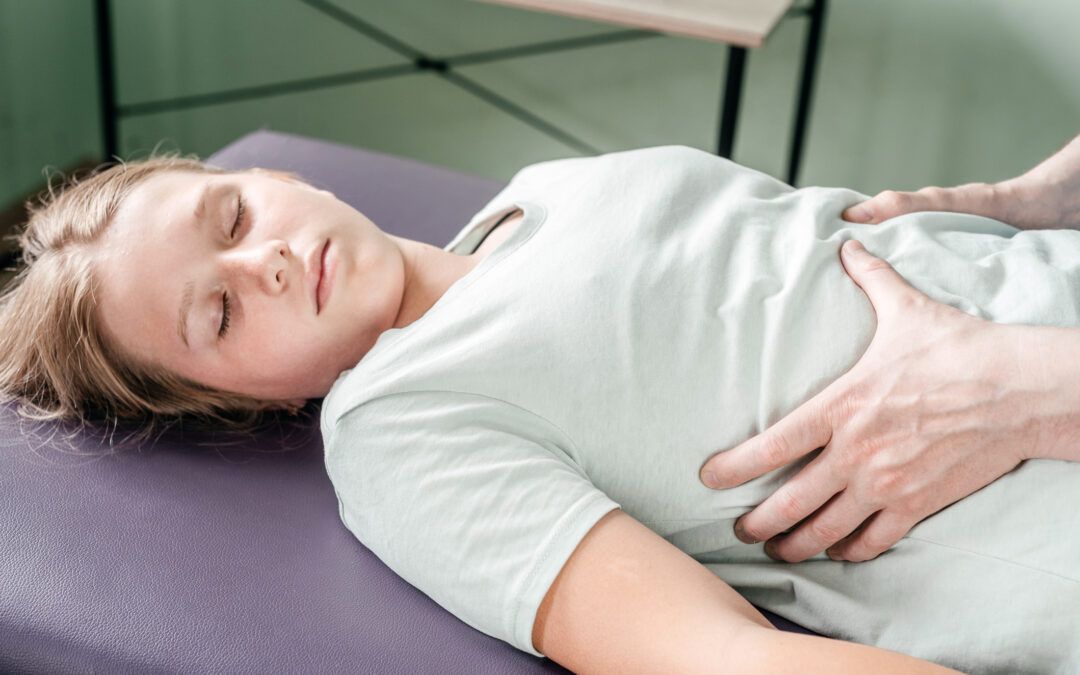By Maria Larrain MPhil BOst DPO PgC ACE (clin ed)
What is cranial osteopathy?
Cranial osteopathy is a gentle osteopathic treatment used to release deep-seated tension from your body.
‘Cranial’ osteopathy is a misnomer because the treatment is applied to your whole body and not just the head. It can be a very effective way of treating a variety of problems suffered by people of all ages gently.
What does a cranial osteopath do that is different?
Cranial osteopathy is not ‘different’ osteopathy because osteopathy is a set of principles. The principles are the same, but the application is different.
Osteopaths who train in the cranial field have extensive postgraduate training to use ‘cranial’ effectively. It may look like osteopaths are ‘laying hands’ but there is more involved than simply touching the body.
The US osteopath William G Sutherland who first started using this approach called it touching with “thinking, knowing, and feeling fingers”.
Cranial osteopathy and ‘cranial sacral therapy’ (CST) differ in that CST can be used by people who are not osteopaths and do not have the same degree of training and skills as osteopaths.
A cranial osteopath works with their hands in a gentle way that is suitable for complex conditions and is a whole-body approach for people who are delicate, either due to age or illness, or simply because it is their preference.
Osteopaths always use techniques according to the person’s needs. Many osteopaths specialise in sports injuries or treatment of viscera. Cranial osteopathy crosses all specialties and is suitable for everyone, even injured athletes.
How does cranial treatment feel?
The patient can feel heat or pressure, either from the osteopath’s hands or in other parts of the body. Sometimes people feel a pleasant tingling sensation or waves of sensation in parts of their bodies. Some people report a fleeting increase in pain during treatment that wanes as the session progresses.
Most patients feel that tension is reduced and then experience a deep sense of relaxation. You may become sleepy during and after treatment. Even as you lie still, your body works very hard to adjust to feeling different.
Although cranial osteopathy is gentle you can still experience some post-treatment discomfort for 24-48 hours, but this is unusual and only if there is significant inflammation present.
Inflammation can take a few days, sometimes even 2-6 weeks to subside in sub-acute cases.
How does cranial osteopathy work?
This is the million-dollar question and our models of explanation and how osteopaths train in the cranial field have changed over the years since Dr William Sutherland.
We know from neuroscience and anthropology that human beings respond to touch. Our nervous systems and bodies are primed for feeling safety and space for healing with gentle touch. When a baby cries it is soothed by its caregivers through touch. When a pet is distressed, it calms down with touch. If a child falls and hits their knee, the first thing we do is touch it to calm the knee and the child down. We do this instinctively. Touch heals because it is soothing for our nervous system.
When the osteopath applies touch, it is with “knowing, thinking, feeling fingers”. We sense for areas where tension is held in the body and which areas are not functioning harmoniously. To allow the body to let go, we understand the need for safety, space, and connection under our hands. It is our nervous system that holds on to the tone in the body or tissues. When our nervous system calms, we release tension.
When tension is released, it helps with blood flow and drainage so local and systemic physiological balance can be restored. These are the core principles of osteopathy: The body constantly strives to heal itself; it functions as a unit; tissues need healthy blood flow, venous drainage, and adequate nerve supply to function optimally.
Cranial osteopathy is gentle and works on the soft tissues, not bone manipulation as some people believe. The approach harnesses the body’s therapeutic potential in our body’s aim to self-heal and self-correct. The osteopath feels for which areas of the body require attention to assist this process. This is why we call it an ‘indirect’ approach. We are not pressing on anything, but merely supporting the body with our hands in a way that supports the body. This is why people report cranial osteopathy to be relaxing. It simply allows you to ‘let go’. If we were just mechanically pressing on parts of the body, nothing will happen. Hence it takes time and training to be able to use this technique therapeutically and effectively.
What can cranial osteopathy help with?
If your condition is amenable to osteopathy, we treat your condition. Otherwise, osteopaths treat people with a condition to maximise function and wellbeing. Many people have osteopathy alongside their usual medical treatment, including physiotherapy.
Using our osteopathic principles, we can help with anything that a person would seek an osteopath for which is usually pain. However, some people find it helpful when they suffer from inability to relax or symptoms related to head and neck, or digestive issues.
We treat people of all ages, including babies.
If you would like to speak to us about how Cranial osteopathy might help you, please call Maria Larrain and book a 15-minute consultation at no cost.
Further reading:
Benedetti, F. (2013). Placebo and the New Physiology of the Doctor-Patient Relationship. Physiological Reviews, 93(3), pp.1207-1246.
Cerritelli, F., Pizzolorusso, G., Renzetti, C., Cozzolino, V., D’Orazio, M., Lupacchini, M., Marinelli, B., Accorsi, A., Lucci, C., Lancellotti, J., Ballabio, S., Castelli, C., Molteni, D., Besana, R., Tubaldi, L., Perri, F., Fusilli, P., D’Incecco, C. and
Barlafante, G. (2015). A Multicenter, Randomized, Controlled Trial of Osteopathic Manipulative Treatment on Preterms. PLOS ONE, 10(5), p.e0127370.
Cerritelli, F., Verzella, M., Cicchitti, L., D’Alessandro, G. and Vanacore, N. (2016). The paradox of sham therapy and placebo effect in osteopathy. Medicine, 95(35), p.e4728.
Colaizzi, P. (1978). Psychological Research as The Phenomenologists View It. In: R. Valle and M. King, ed., Existential Phenomenological Alternatives for Psychology. New York: Oxford University Press.
Colaizzi’s descriptive phenomenological method. (2018). Te.
Consedine, S., Standen, C. and Niven, E. (2016). Knowing hands converse with an expressive body – An experience of osteopathic touch. International Journal of Osteopathic Medicine, 19, pp.3-12.
Craig, A. (2009). How do you feel — now? The anterior insula and human awareness. Nature Reviews Neuroscience, 10(1), pp.59-70.
Crucianelli, L., Metcalf, N., Fotopoulou, A. and Jenkinson, P. (2013). Bodily pleasure matters: velocity of touch modulates body ownership during the rubber hand illusion. Frontiers in Psychology, 4.
Curi ACC, Maior Alves AS, Silva JG. 2018 Cardiac autonomic response after cranial technique of the fourth ventricle (cv4) compression in systemic hypertensive subjects. J Bodyw Mov Ther Jul;22(3):666-672 https://www.sciencedirect.com/…/pii/S136085921730339X
Cutler MJ, Holland BS, Stupski BA, Gamber RG, Smith ML 2005 Cranial manipulation can alter sleep latency and sympathetic nerve activity in humans: a pilot study. The Journal of Alternative and Complementary Medicine Feb;11(1):103-8. http://www.ncbi.nlm.nih.gov/pubmed/15750368
Elbrecht, C. and Antcliff, L. (2014). Being touched through touch. Trauma treatment through haptic perception at the Clay Field: A sensorimotor art therapy. International Journal of Art Therapy, 19(1), pp.19-30.
Ellingsen, D., Wessberg, J., Chelnokova, O., Olausson, H., Laeng, B. and Leknes, S. (2014). In touch with your emotions: Oxytocin and touch change social impressions while others’ facial expressions can alter touch. Psychoneuroendocrinology, 39, pp.11-20.
Field, T. (2010). Touch for socioemotional and physical well-being: A review. Developmental Review, 30(4), pp.367-383.
Finlay, L. (2009). Ambiguous Encounters: A Relational Approach to Phenomenological Research. Indo-Pacific Journal of Phenomenology, 9(1), pp.1-17.
Gazzola, V., Spezio, M., Etzel, J., Castelli, F., Adolphs, R. and Keysers, C. (2012). Primary somatosensory cortex discriminates affective significance in social touch. Proceedings of the National Academy of Sciences, 109(25), pp.E1657-E1666.
Husserl, E. (1982). General introduction to a pure phenomenology. The Hague: M. Nijhoff.
Jakel A, von Hauenschild P 2011 Therapeutic effects of cranial osteopathic manipulative medicine: a systematic review. J Am Osteopath Assoc Dec;111(12):685-93. http://www.ncbi.nlm.nih.gov/pubmed/22182954
Kneebone, R. (2018). In Practice: Getting Back in Touch. Comment Lancet, 391:723.
Lee-Treweek, G. (2002). Trust in complementary medicine: the case of cranial osteopathy. The Sociological Review, 50(1), pp.48-68.
McGlone, F., Cerritelli, F., Walker, S. and Esteves, J. (2017). The role of gentle touch in perinatal osteopathic manual therapy. Neuroscience & Biobehavioral Reviews, 72, pp.1-9.
McGlone, F., Wessberg, J. and Olausson, H. (2014). Discriminative and Affective Touch: Sensing and Feeling. Neuron Perspective, 82(4), pp.737-755.
Merleau-Ponty, M. (1962). Phenomenology of Perception. London: Routledge & Kegan Paul Ltd.
Merleau-Ponty, M. (1962). Phenomenology of Perception. London: Routledge & Kegan Paul Ltd.
Milnes K, Moran RW 2007 Physiological effects of a CV4 cranial osteopathic technique on autonomic nervous system function: A preliminary investigation International Journal of Osteopathic Medicine 10(1):8-17 41 http://www.sciencedirect.com/…/pii/S1746068907000089
Morrow, R., Rodriguez, A. and King, N. (2015). Colaizzi’s descriptive phenomenological method. The Psychologist, 28(8), pp.643-644.
Nelson KE, Sergueef N, Glonek T. 2006 The effect of an alternative medical procedure upon low-frequency oscillations in cutaneous blood flow velocity. Journal of Manipulative and Physiological Therapeutics Oct;29(8):626-36 http://www.ncbi.nlm.nih.gov/pubmed/17045096
Nelson KE, Sergueef N, Glonek T 2004 Cranial Manipulation Induces Sequential Changes in Blood Flow Velocity on Demand The AAO Journal September, 15-17 https://www.researchgate.net/…/277020621_Cranial…
Øberg, G., Normann, B. and Gallagher, S. (2015). Embodied-enactive clinical reasoning in physical therapy. Physiotherapy Theory and Practice, 31(4), pp.244-252.
O’Malley, J. (2004). Body As a Teacher: The Roles of Clinical Model and Morphology in Skill Acquisition. In: O. Kathryn S. and H. Servando Z., ed., Healing By Hand: Manual Medicine and Bonesetting in Global Perspective, 1st ed. Altamira Press.
Perrin RN, Edwards J, Hartley P 1998 An evaluation of the effectiveness of osteopathic treatment on symptoms associated with Myalgic Encephalomyelitis. A preliminary report Journal of Medical Engineering & Technology January/February
Rechberger V, Biberschick M, Porthun J, 2019 Effectiveness of an osteopathic treatment on the autonomic nervous system: a systematic review of the literature European Journal of Medical Research 24:36 https://doi.org/10.1186/s400-019-0394-5 https://eurjmedres.biomedcentral.com/…/s40001-019-0394…
Sandhouse ME, Shechtman D, Sorkin R, Drowos JL, Caban-Martinez AJ, Patterson MM, Shallo-Hoffmann J, Hardigan P, Snyder A 2010 Effect of Osteopathy in the Cranial Field on Visual Function‚ A Pilot Study J Am Osteopath Assoc 110: 4, April; 239-240 https://www.ncbi.nlm.nih.gov/pubmed/20430912
Sergueef N, Nelson KE, Glonek T 2002 The effect of cranial manipulation on the Traube-Hering-Mayer oscillation as measured by laser-Doppler flowmetry. Altern Ther Health Med. Nov-Dec;8(6):74-6. http://www.ncbi.nlm.nih.gov/pubmed/12440842
Shi X, Rehrer S, Prajapati P, Stoll ST, Gamber RG, Downey HF. 2011 Effect of cranial osteopathic manipulative medicine on cerebral tissue oxygenation. J Am Osteopath Assoc Dec;111(12):660-6. https://www.ncbi.nlm.nih.gov/pubmed/22182951
Silk, J. (2002). Using the ‘F’-word in primatology. Behaviour, 139(2), pp.421-446.
Sutherland, W., Sutherland, A. and Wales, A. (1998). Contributions of thought. Portland, Or.: Ruda Press.
Tufford, L. and Newman, P. (2010). Bracketing in Qualitative Research. Qualitative Social Work: Research and Practice, 11(1), pp.80-96.
Valentine, D. (1991). Pulse As An Icon in Siddha Medicine. In: D. Howes, ed., The Varieties of Sensory Experience: A Sourcebook in the Anthropology of the Senses, 1st ed. Toronto: University of Toronto Press.
Van Manen, M. (1999). The Pathic Nature of Inquiry and Nursing. In: I. Madjar and J. Walton, ed., Nursing And The Experience of Illness: Phenomenology in Practice. London: Routledge, pp.17-35.




